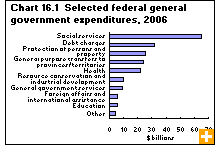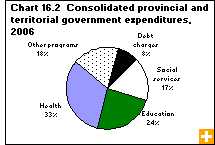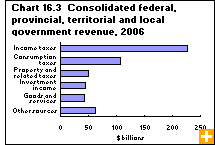Common menu bar links
Government
Archived Content
Information identified as archived is provided for reference, research or recordkeeping purposes. It is not subject to the Government of Canada Web Standards and has not been altered or updated since it was archived. Please contact us to request a format other than those available.
Our three levels of government provide Canadians with many services that cannot be easily provided by private companies—the federal government is responsible for national defence and international diplomacy, for example. The provinces and territories, meanwhile, ensure that Canadians have access to essential services such as health care and education. Local governments take care of keeping our streets clean and our communities safe.
The constitution spells out the responsibilities of each level of government. But governments’ accounting books shows where their priorities lie and where they spend taxpayers’ dollars. All told, in 2005/2006 our governments spent $516 .9 billion providing Canadians with goods and services.
In 2005/2006, on a per capita basis, the federal government spent $6,794 for every man, woman and child in the country, and the provincial, territorial and local governments spent another $10,839 per capita.
But these averages vary widely, particularly among the provinces and territories. The high cost of providing services in Canada’s North means that Nunavut spent $38,859 per capita, while the provincial per capita spending ranged between $10,000 and $15,000.
Where the federal money goes
The single largest expense for the federal government is social assistance. In 2005/2006, social security payments, family allowances and income maintenance programs cost just over $57.4 billion, a 9.6% increase since 2001/2002.
Federal expenditures for health care services jumped to $23.8 billion in 2004/2005 from $6.8 billion in 2003/2004. In 2005/2006, it was $21.8 billion. The increase in 2004/2005 was mainly because of the new Canada Health Transfer—a specific transfer payment for health care to the provinces and territories—which amounted to $14.0 billion in 2004/2005. Prior to 2004, the federal transfers for health care were part of a general purpose transfer called the Canada Health and Social Transfer. Accordingly, general purpose transfers declined from $29.6 billion in 2003/2004 to $21.0 billion in 2004/2005.
The protection of persons and property is another big-ticket spending item for the federal government—the military, federal policing, prisons and courts cost $25.5 billion in expenditures in 2005/2006.
Provincial and territorial spending
Providing hospital and medical care is the primary responsibility of the provinces and territories, and they collectively spent $93.8 billion on health care in 2005/2006. The combination of increased federal transfers for health care, an aging population and the rising cost of medical services has pushed spending in this area up by over one quarter since 2001/2002.
Schooling Canadians is the second largest expense for the provincial and territorial governments—to the tune of $70.6 billion in 2005/2006. Elementary, secondary and postsecondary education absorbs 96% of this spending.
The local level
Elementary and secondary education, keeping neighbourhoods clean and secure and providing local infrastructure are the biggest expenditures at the local level. In 2005, elementary and secondary education amounted to $40.1 billion. Municipal governments spent $10.5 billion on environmental programs—such as water purification and garbage collection—and another $9.8 billion on protection of persons and property.
Building and maintaining roads and streets and providing other transportation services cost local governments another $11.8 billion.
Taxes and other revenue sources
Running the country is expensive. Without collecting taxes from the population, our governments could not provide the services that Canadians have come to expect. In 2005/2006, all levels of government raised a total of $403.7 billion in taxes, about $70.0 billion more than in 2001/2002.
More than half of that total (56.3%) came from income taxes: personal income taxes totalled $169.2 billion and corporate income taxes amounted to $51.1 billion. Consumption taxes, such as gasoline taxes, customs duties and those on alcohol, tobacco and gambling—added another $108.0 billion; the provinces and territories collected more than half of these taxes. Property taxes totalled $49.6 billion—most of this money goes directly to local governments.
Governments also collect revenue from other sources. In 2005/2006, they collectively earned $45.3 billion from investment activities and sold $43.1 billion worth of goods and services—such as student tuition fees and municipal water.
Together, Canada’s three levels of government and the Canada and Quebec Pension Plan accounts have pulled in more money than they have spent in every year since 1999/2000. This followed a string of deficits. However, much of this surplus is occurring at the federal level, in Alberta, and within the Canada and Quebec Pension Plan accounts. Moreover, while the federal government has seen successive surpluses since 1997/1998, the 13 provincial and territorial governments together have posted only four surplus years during the last decade.
Public sector employees
Of Canada’s 16.5 million workers in 2006, just over 3.1 million worked in the public sector. About 1.1 million of these public sector employees worked for the governments themselves, while 976,000 worked for educational institutions and 780,000 were employed with health care and social services providers.
Collectively, these public sector employees—our policemen, postal workers, diplomats, sanitation workers, health care workers, bureaucrats and other government service providers—earned $151.2 billion in wages in 2006. The public sector wage bill was flat or falling from 1994 to 1997, but then climbed by nearly 50% by the end of 2006.





